what notes to play in a g major drone
The major scales are the building blocks of music, mastering them is the first pace to learning to play quickly in any key.
What Are Scales
Scales are collections of the eight notes that make up a key. If you were to use merely those notes, yous could make melodies and harmonies that would audio good together. For you history buffs, or if y'all just want to rock on trivia night, then retrieve that the word scale comes from the Latin discussion "Scala," which means ladder. If yous look at a scale, it looks like a ladder where each rung is a note that fits in the central signature.
When reading scales, you'll notice that the primal is set in the key signature, non by accidentals on each annotation.
Each key also has character traits. Some seem aroused and could exist used when writing pieces well-nigh state of war, others sad, and some joyous.
The 12-Major Scales
C Major Scale
The C-Major calibration is one of the beginning scales we larn because it doesn't contain any sharps or flats. 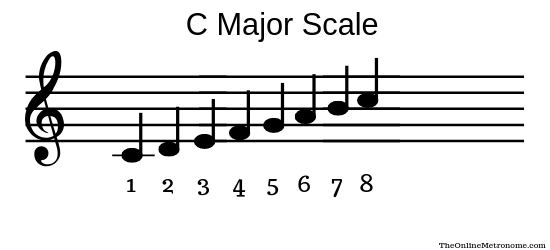
The C-Major scale is made of the notes: C, D, Eastward, F, G, A, B, C. If you were to play this scale on the piano, it would contain but white keys.
Since there are no sharps or flats in C-Major, information technology is considered to take a "pure" character. Information technology conveys a sense of innocence and simplicity. One of the nigh famous symphonies in C Major is Beethoven'south Symphony No. 1.
D Major Calibration
The D-Major scale contains 2 sharps in the central signature, F-sharp and C-sharp. 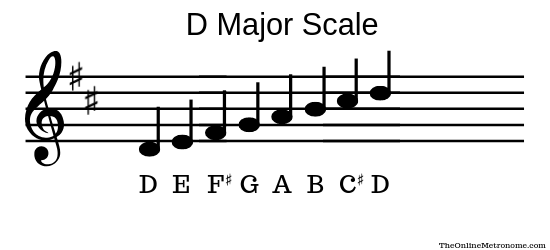
The D-Major scale is made up of the notes: D, East, F-abrupt, 1000, A, B, C-sharp, and D.
The primal of D is representative of triumph and victory. For this reason, many marches, religious, and vacation songs are written in D-Major. Brahms' Symphony No. 2 is in D-Major is an example of a composition using this key.
E Major Scale
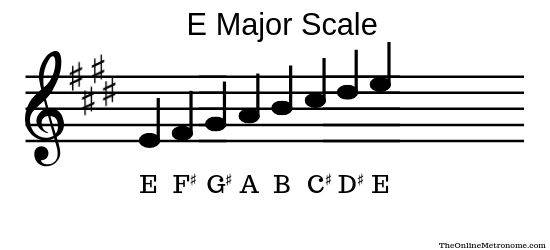
East-Major contains 4 sharps. The calibration is comprised of: E, F-abrupt, Grand-precipitous, A, B, C-sharp, D-sharp, and E.
The cardinal of E-Major is a joyous key, even sometimes described as "joyous laughter." A symphony that uses the fundamental of E-Major is Anton Bruckner'southward Symphony No. 7.
F Major Scale
The key of F-Major has one apartment, B-apartment. It is made upwards of: F, G, A, B-flat, C, D, E, F. 
The key of F-Major is described as conceited and calm. Antonin Dvorak's Symphony No. 5 in F-Major is written in a pastoral manner, which explains why he chose this key for his composition.
One thousand Major Calibration
The key of G-Major has just one sharp: F-precipitous. It'south comprised of the notes: G, A, B, C, D, Due east, F-precipitous, G. 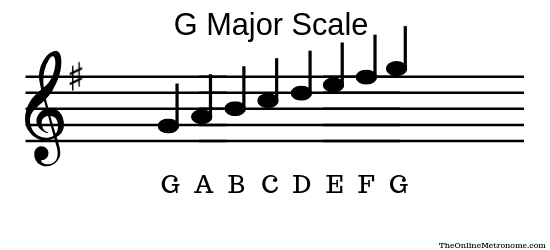
The key of Grand-Major is rustic and idyllic. Information technology evokes feelings of tenderness and friendship. Gustav Mahler'south Symphony No. 4 is a adept example, as information technology is meant to depict a child'southward view of Heaven.
A Major Scale
A-Major has three sharps (F-sharp, C-precipitous, and Grand-sharp). The calibration is made up by: A, B, C-Abrupt, D, East, F-Precipitous, G-Precipitous, A. 
The fundamental of A Major elicits feelings of innocent beloved and trust. Felix Mendelssohn'southward Symphony No. 4 is in A-Major. Mendelssohn was inspired to compose this work by the dazzler of Italian republic. He said "This is Italy! And now has begun what I have always thought... to be the supreme joy in life. And I am loving it."
B Major Scale
B-Major has five sharps in the central signature. They are F-precipitous, C-abrupt, Chiliad-sharp, D-sharp, and A-sharp. The calibration is fabricated up of: B, C-sharp, D-sharp, E, F-sharp, K-sharp, A-sharp, B. 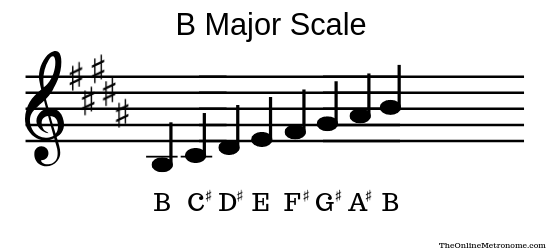
The central of B-Major is one of wild passion. It tin represent emotions of intense love, anger, jealousy, and rage. It is i of the few major keys that symbolizes negative emotions. Dmitri Shostakovich's Symphony No. two is written in B-Major, which was written to commemorate the 10th anniversary of the October Revolution. It was an event that was seen every bit triumphant simply also was an armed coup. This highlights the disharmonize between love and rage.
D-Flat Major Scale
The next 2 scales, D-Apartment Major and C-Sharp major are enharmonic equivalents.
This means that while they look different, they volition sound the same. C-abrupt and D-flat are the same pitch. That said, some people have an easier time reading sharp or flats, and one of these keys might brand more sense when looking at related keys or chord progressions.
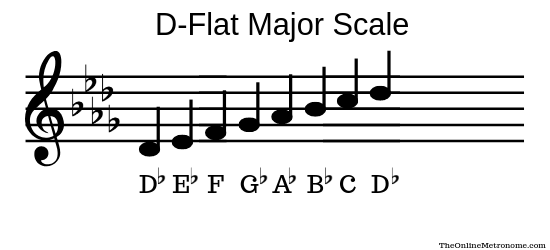
The D-Flat Major calibration has v flats: B-flat, E-flat, A-flat, D-flat, and G-flat. It is a primal described as being moderate just capable of expressing a range of emotions. It can be happy, but not joyous, or it can exist distressing, but non in agonizing hurting. A symphony composed in D-Apartment is Howard Hanson'due south Symphony No. 2.
C-Sharp Major Scale
At present that you know the D-Flat major scale, yous as well know the C-Sharp major scale. Go notation by annotation through these two scales and you lot will see that they are the aforementioned, but expressed differently.
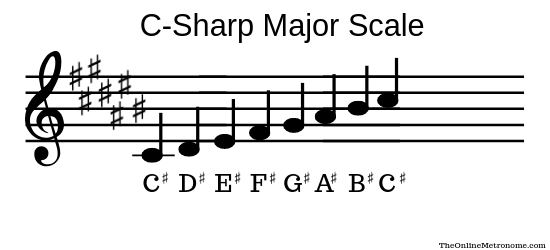
The C-Precipitous major scale has 7 sharps: F, C, Thou, D, A, East, B. So yes, every single note in this calibration is abrupt. Since this scale sounds, to the ear, the aforementioned as the D-Flat Major scale, it has similar musical graphic symbol traits. That said, in compositions, these ii keys might exist approached differently, which volition accept a dramatic bear upon on the feelings they convey. Many more than composers accept written symphonies in C-sharp over D-flat. One famous instance is Mahler's Symphony No. 5.
E-Flat Major Calibration
E-apartment Major has three flats: B-flat, E-apartment, and A-apartment.
E-flat is the key of beloved and devotion and is made up of the notes: E-flat, F, Thou, A-flat, B-apartment, C, D, and E-apartment. A famous work in the central of E-flat is Beethoven's Symphony No. 3 "Eroica". This piece was originally dedicated to Napoleon, which speaks to the idea of admiration (love and devotion).
One thousand-Apartment Major Scale
The M-Apartment Major scale is some other calibration that is an enharmonic equivalent. K-flat can as well be written as F-sharp.
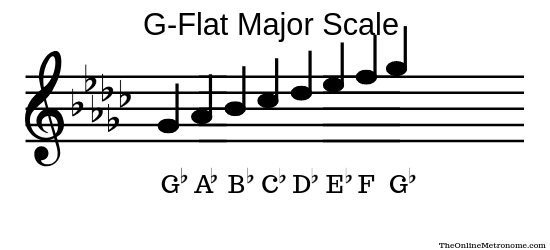
K-Flat major has vi flats, meaning every annotation in this scale is apartment except for F. (Chiliad-apartment, A-flat, B-apartment, C-flat, D-apartment, E-flat).
F-Sharp Major Scale
Now that y'all know Chiliad-flat, you also know F-sharp. Become through slowly and you'll see that you use the same fingerings and the pitches are the same.
F-Precipitous Major has six sharps: F-abrupt, C-sharp, G-sharp, D-sharp, A-precipitous, and Due east-sharp.

The F-sharp major scale is made up of the notes: F-abrupt, G-sharp, A-abrupt, B, C-sharp, D-precipitous, Due east-sharp, and F-sharp. Its character is described as proclaiming triumph over difficulty (which is certainly true if you lot try to play through it). This key tells the story of a difficult struggle and ultimate triumph.
Since this is such an bad-mannered key for many instruments to play, it is rarely used for symphonies. One of the more than famous examples is Mahler's Symphony No. 10 in F-precipitous. Interestingly, this was Mahler's last symphony and he was unable to complete it before his death. This work picks upward correct where Symphony No. nine leaves off (starting with a theme from the previous piece of work) and so works through hard music filled with mixed meter and dissonance. Finally, it ends in triumph, illustrating the struggle but ultimately a successful cease.
A-Flat Major Scale
The key of A-Apartment Major has four flats: B-flat, E-apartment, A-apartment, and D-apartment.

The A-apartment major scale is fabricated up of the notes: A-flat, B-flat, C, D-flat, E-flat, F, G, and A-flat.
This key is a somber 1, ofttimes associated with decease and judgment. Edward Elgar wrote his first symphony in the central of A-flat, though he believed that music shouldn't have to tell a story, rather it tin be just to be. That said, he described the opening theme (in A-flat Major) equally "simple, noble, and elevating." Perhaps it was the somber and simple nature of A-flat that prompted him to utilize this fundamental.
B-Flat Major Scale
B-flat Major has 2 flats in the key signature: B-flat and Due east-flat.
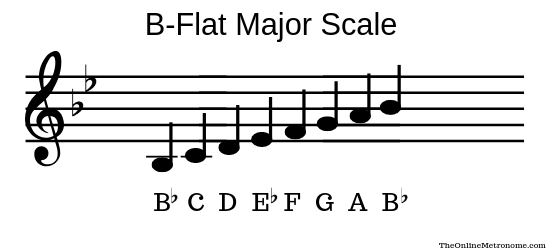
The B-flat Major scale is made of the notes: B-flat, C, D, Eastward-flat, F, G, A, and B-apartment. This fundamental is described as cheerful and optimistic. A wonderful case of a work in B-flat Major is Prokofiev'southward Symphony No. five. It was written during World State of war 2, which was a very difficult time to be in Soviet Russia. He described the work every bit "a hymn to free and happy Man, to his mighty powers, his pure and noble spirit." This beautifully captures the optimism that this work was supposed to convey, making the primal of B-flat very appropriate.
How to Practice Scales
Scales are the building blocks of music. Learning scales will allow yous to more speedily read notes within a key signature and to experience more comfy playing these combinations of fingerings.
Here is a simple procedure for learning a new scale:
- Print out two copies of the scale.
- On one copy, write out the fingering for each note underneath the note.
- Going very slowly, and not playing, say the notation name and press the fingering for the note.
- When you experience comfortable with the fingerings, play through the calibration very slowly.
- Repeat this process until you have done it perfectly ten times.
-
Now that you lot experience confident with the fingerings, close your optics and encounter if you can play the scale perfectly. Yous've learned the basics of the scale, now information technology is fourth dimension to become information technology in rhythm! A technique I recommend is the following:
-
Number the notes of the scale, one-8.

-
Now, y'all're going to gradually build the scale, bit by bit. Start with just playing 1 - two - i.

-
One time you tin play it perfectly 3 times in a row, add another note.
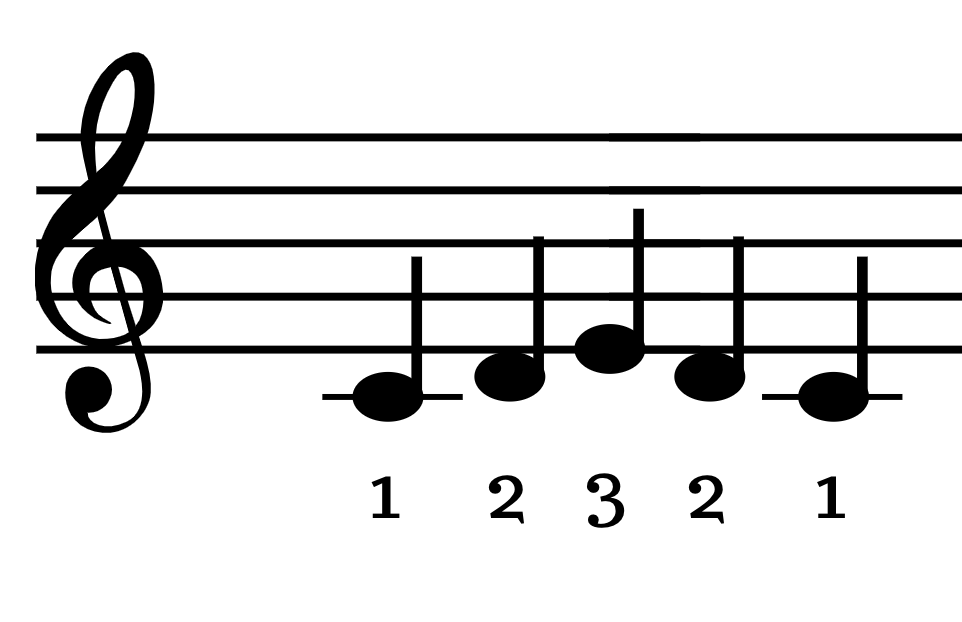
-
Continue building the scale so in this fashion. Playing the clamper until you have information technology right three times in a row, and so add another scale degree.

-
Repeat until you have played the unabridged scale. If you are just starting out, this will exist to the eighth scale degree. If you are learning multiple octaves, then keep going! Add a ninth, 10th, eleventh scale degree. You know what notes come adjacent as the aforementioned eight notes repeat over and over in scales.
chartiereashe1969.blogspot.com
Source: https://theonlinemetronome.com/blogs/16/major-scales
0 Response to "what notes to play in a g major drone"
Post a Comment